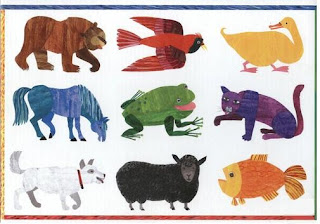How many of you have read "Brown Bear, Brown Bear, What Do You See?" It is easily a classroom and family favorite. I have seen a few really nice accessible books for our kids to read this beloved series. I was recently hanging out in one of our preschool classrooms and saw how one teacher, Catherine D., made accessible copies for each of her students to read. These DIY is easy. You need the textured materials (feathers, cotton balls, etc), tracing paper, print out of the story and Braille labels. Catherine has allowed me to share the entire book.

How did they get the animals cut out so perfectly? Use tracing paper and then copy over to your textured paper. She then bound each copy so that students had their own copies. I am a big supporter of multiple copies of textured times because it is so helpful when you have multiple students that need it.
Remember that when you are making textured books to focus on the main concept of the picture for texture. Look at the blue bird and the teacher pages. The focus of each picture is simple, blue feathers or the eyes of the teacher. No need to go crazy with your textures!
Another thing to keep in mind is to keep the print location constant. This will help students anticipate where the print is located.
The last page of this accessible version is the part where the book asks the student, "who do you see?" There is a 'mirror' there with a picture of the student.



















